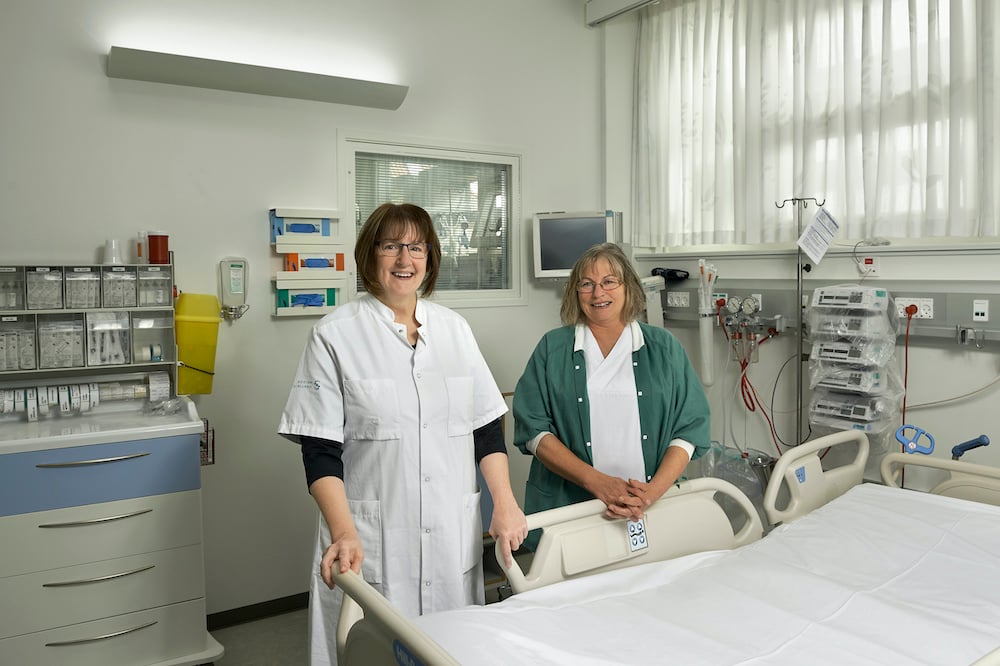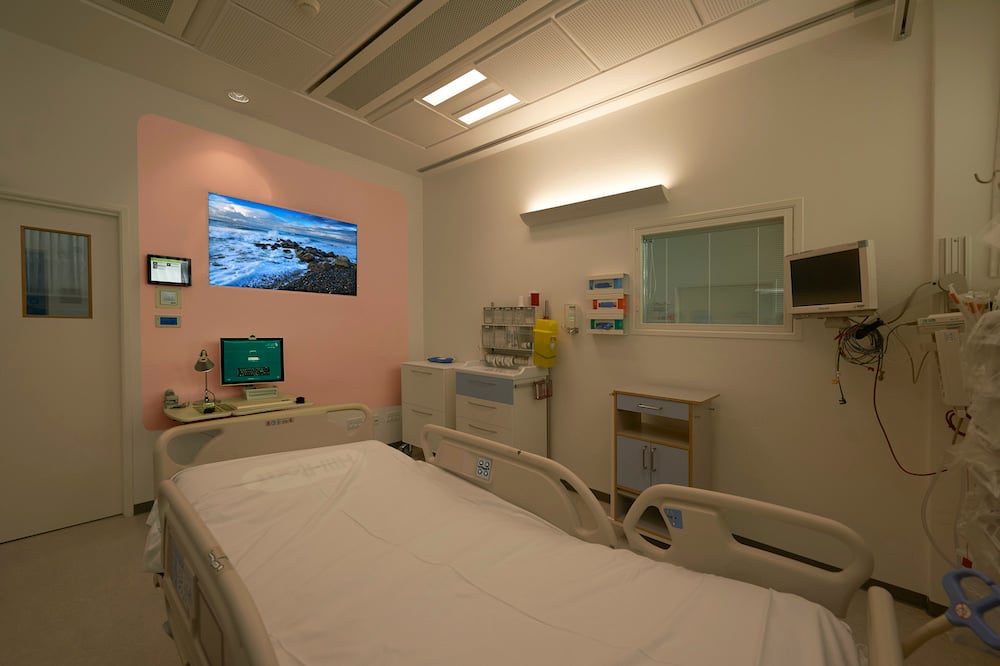The intensive care unit at Holbæk Hospital has undergone a remarkable transformation. The patient rooms and corridors have been completely renovated and now gleam with a fresh new look. New specialized beds, furniture, and lighting have been installed. The enthusiastic staff members are particularly delighted that they now work in the sunshine all day long, even when it's raining outside.
— It's not just the light that's new - it's the light that makes all the difference. The light sparked it all.
Melinda Frandix, the head nurse at the intensive care unit of Holbæk Hospital, expressed her satisfaction with the completion of the unit's total renovation. Alongside department nurse Susanne Larsen, she was delighted to have achieved their goal of transforming the intensive care department.
— Previously, we worked in a dimly lit bunker or a basement - that's how it felt, at least. The lighting conditions were terrible. Everything was dark, and the department was designed 40 years ago. A measurement of the lighting conditions was an argument in itself. Something needed to be done, Susanne Larsen explains.
The light at the top of the wish list
A group of three ICU nurses had heard about Ergonomic Circadian Lighting during a course in 2012 and subsequently visited Kolding Hospital to see it in action. When they returned, Melinda brainstormed ways to secure funding for the new lighting, which was at the top of the department's wishlist.

— It eventually led to me approaching the hospital director and making a deal, Melinda Frandix reveals, continuing her story.:
— My starting point was that if we could generate a surplus in the budget, it should go towards Ergonomic Circadian Lighting, with the expenses being split equally. Fortunately, we have visionary and proactive leadership that is responsive to our wishes and needs. The management wants to modernize and make the hospital up-to-date, so I received a positive response to the lighting agreement. We had two lighting companies provide quotes and chose Chromaviso, whom we were familiar with for their Ergonomic Lighting in the operating room. Around the same time, we applied for funding from the Region for the total renovation of the department - and luckily, we were granted funds of 4.3 million. Our technical manager, Bianca ter Haar, has been driving the project with great dedication alongside Susanne.
Ergonomic Circadian Lighting has made a difference
— We have experienced a significant uplift in the department, and the staff is truly delighted with it - especially with the lighting, emphasized department nurse Susanne Larsen, continuing her statement:
— We anticipate that the patients will experience improved sleep quality. For the staff, it feels like working in the sunshine. A nurse spontaneously remarked that she feels less tired with the new lighting. However, it has also been a challenging year as we had patients during the renovation, which lasted until the end of February. Our intensive care unit is a general department where patients are stabilized before being transferred to the ward. We provide observation, treatment, and care for critically ill patients with compromised lung, heart, and circulatory functions. This includes patients with severe injuries, infections, or blood clots and haemorrhages in the heart, brain, or lungs. We also have patients who have undergone major surgeries.

According to Susanne Larsen, the staff consists of 56 employees, some of whom work part-time, which means there are approximately 73 nurses. In a year, they handle nearly 800 patients.
— The average length of stay is 2 ¼ days, and we are constantly by the patients' side, day and night. Previously, we had to turn on bright lights in the entire room when we needed to work clinically at night. Now, we have Ergonomic Circadian Lighting with special night spots. It makes a huge difference. The lighting follows the sun's rhythm throughout the day and is equipped with a special night light that does not disrupt the production of melatonin, which is produced in darkness and inhibited by daylight. This way, the patient's circadian rhythm is stabilized, and the risk of intensive delirium is reduced, she explains.
A whole new world
Melinda Frandix proudly gives a tour of the newly renovated intensive care unit, showcasing the nine beautiful patient rooms. The entire space exudes a fresh and inviting atmosphere.
— Yes, it's a remarkable leap we've taken. We are so proud, but we have also fought for it and been involved in every detail. All the furniture is new and on wheels. We have installed new glass cabinets in the hallway, and we have purchased nine special intensive care beds - so-called computer beds that can be turned and twisted. It is important for us that the patient room feels like a homely space, where it's pleasant to be. That's why we have invested in an illusion window in each room, which is a screen displaying nature images. Together with the soft pastel colour on the walls, it makes the room feel less clinical, she explains.

— And then there's the Ergonomic Circadian Lighting, which has been installed and adjusted multiple times. We have had the lighting for about 8 weeks in all nine patient rooms and the hallway, but not in the storage rooms and medication rooms. It truly makes a difference for both patients and staff. However, it required an active effort to implement Ergonomic Circadian Lighting in an educational manner. The principles must be followed, for example, the light should not be turned off or dimmed during the day. It's a whole new world, says Melinda Frandix.
The workflow in the intensive care unit at Holbæk Hospital forms the basis for the programming of the Ergonomic Circadian Lighting. The sun rises and sets at specific times each day, ensuring that intensive care patients maintain a stable circadian rhythm. The Ergonomic Circadian Lighting is controlled by a user-friendly touch panel on the wall, offering eight different settings. The night light is specially designed not to disrupt the production of the sleep hormone melatonin, which regulates the circadian rhythm.
About Ergonomic Circadian Lighting
Ergonomic Circadian Lighting is an artificially created light that mimics the natural rhythm of the sun, combined with a specially developed night light that is not disruptive to the circadian rhythm. This unique lighting concept, developed by Chromaviso, ensures optimal lighting conditions in departments with round-the-clock activity. Ergonomic Circadian Lighting helps restore patients' circadian rhythm and also protects employees working night shifts from the negative effects of traditional artificial light.
How It Works
Light affects our circadian rhythm through the production of melatonin, a hormone that regulates our sleep-wake cycle. Melatonin is produced in the brain (specifically the pineal gland) and is influenced by light entering the eye. The production of melatonin varies throughout the day due to the impact of light. The retina in the eye captures the light, and specialized cells in the retina detect the different spectrums of light. These special cells in the retina have nerve connections with the SCN (suprachiasmatic nucleus), which acts as a conductor, determining the rhythms of our cells. Therefore, the SCN plays a crucial role in regulating the body's functions.
Many critically ill and vulnerable patients are often unable to leave the hospital and therefore lack exposure to natural sunlight, which can disrupt their circadian rhythm. By providing long-term hospitalized patients with light that mimics natural circadian light, their natural rhythms are preserved, ultimately improving their well-being.

